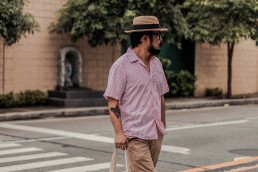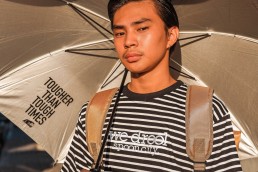
When I was around seven or eight, my family took me to Enchanted Kingdom for my birthday—a welcome surprise after a year of catching up with classes and spending my break times alone. Seeing as we lived quite a distance from Santa Rosa, we woke up way before our usual hours and piled up into a rental van, taking off just before the sun rose. By the time we arrived, the park was still closed, so we sat in our seats finding ways to keep ourselves preoccupied. I couldn’t stay still, however—I was hounded by an ungodly mixture of boredom and anticipation, itching to take hold of the park rides finally. After all, when you’re young, there’s nothing quite like the thrill of your first amusement park.
Over the years, I’ve had my fair share of amusement parks both here and abroad, each with their unique thrills and experiences. But whether I’m at Sky Ranch or Disneyland, I find myself going back to being seven or eight, riding the Flying Fiesta and thinking I was soaring above the world.
Indeed, for a good number of us, Enchanted Kingdom was the amusement park that first captured our imaginations and brought us to places we’ve never been to before—whether it be the exhilaration of riding a roller coaster that’s larger than you are, or bonding with loved ones through mutual scares. In a sense, EK has become an institution that’s characterized a particular aspect of Filipino social life that isn’t often explored.

The Philippines is no stranger to amusement parks. From the rides bedecking nearby school fairs to the seasonal—sometimes permanent—perya present in every fiesta, the amusement park is a recreational gathering spot whose appeal comes from the thrills it provides, be it a high-stakes bingo game or a rickety octopus ride. One could say that its allure is predicated on escapism, the easiest being an adrenaline rush. However, it takes a special kind of park to transcend mere physical exhilaration.
Like many establishments, there’s a science that goes into the creation of a themed amusement park; a good portion of it psychological. While some parks might choose to go the thrill-oriented route, others like EK focus on the “bonding” aspect of it, serving as an avenue for deeper connections. Trixie Mercado, a Santa Rosa native, recalled for instance how EK’s haunted house attraction—then themed after Shake, Rattle, and Roll—helped bring her and her siblings closer. “We don’t really hold each other up, but the whole time in the haunted house we were really close to each other,” she said. “We aren’t really super physically intimate, but at the time we had no choice ’cause we were so scared. It was a fun experience.”
Not surprisingly, the idea for EK sprung out of a familial enjoyment for such attractions. Cesar Mario Mamon, founder and CEO of Enchanted Kingdom, noted how he and his family would often visit fun fairs back in the day, particularly with their young kids. He said, however, that they were mostly an amalgamation of rides—there had yet to be an actual theme park in the Philippines. “That time, in the early 90s, our families were just starting to grow. We always enjoyed going to seasonal carnivals… of course, you had Fiesta Carnival, and you had Star City,” he said. “And then that gave us the idea—why does the Philippines not have its own themed amusement park that can be open all year-round?”

With the capital gained from their real estate business, they initially sought to bring in more established parks into the country, such as Disneyland and Universal Studios. For a while, they corresponded with Knott’s Berry Farm on bringing their IP into the country. After a while, however, they decided to develop their own theme park and intellectual property—i.e. Eldar the Wizard and such—but nonetheless followed Knott’s family-friendly orientation.
“Basta what we talked about was to have a place for families and friends as a whole to enjoy,” said Mamon. “A place where it’s not like the traditional perya, where you walk on gravel and mud. Here you walk on concrete or grass, and the rides are not of the scale that you see in the smaller parks, but something grander. The ultimate goal was to elevate the amusement and attractions industry to an international level here in the country—for Filipinos in general.”
Being first-timers in the amusement industry, they sought out consultants and designers to help them both with the overall look of the park and the operational aspects of it. “We met with some designers and consultants—namely Landmark Entertainment from Burbank, California, who did the overall concept and design of Enchanted Kingdom. Then we had consultants from International Theme Park Services Inc. or ITPS of Cincinnati, Ohio who helped us with operations, maintenance, and safety,” said Mamon. “Landmark had a creative director to oversee the overall theming of the park during construction with a team of locally trained creative artists, and then ITPS had a man on the ground for three years to handhold us with operations safety and maintenance.”
Interestingly enough, the initial concept for EK presented to the owners had been heavily inspired by local architecture, after designers saw the Ifugao houses in Nayong Pilipino. Called “Great Escapes,” the park’s initial logo featured a carabao driving a jeepney. But while it was an interesting concept, they sought to take a more out-of-the-box approach. “The guiding principle is that when you enter the park, you go on an escape from reality,” said Mamon. “You don’t want to be reminded of your day-to-day problems. If you go inside the park, you don’t want to see a facade of buildings in Makati or Ortigas, di ba? You want to travel, whether it’s to other parts of the world or other parts of the universe.”
This guideline would translate into the park’s seven theme zones, partially inspired by different times in history that Mamon and the team were enamored with. For instance, Midway Boardwalk—where one could find Anchor’s Away and EKstreme Tower—was based on the Coney Island era in New York, while Brooklyn Place was taken from the cinema culture of the ’30s-’40s. The result is a grand variety of places to explore and attractions to visit, giving patrons more choices to ride and dine.
And for some, the variety is what gives it an edge over other local amusement parks. Kevyn Gohu, who first went to EK when she was five or seven, recalled how she and her family would either go to EK or Dreamscape—the now-defunct carnival located on the top floor of Robinsons Galleria—for their amusement park fix. But while they went to Dreamscape more often due to distance, she noted how she found EK better due to their diverse offerings. “It had two roller coasters. In Dreamscape, there was only one,” she said. “There was also the Rio Grande, the Flying Fiesta—the chairs flying in the air. There was also more food.”
But beyond mere variety, EK also commits to the look of each of its theme zones, ensuring that each detail keeps close to the period or place they wanted to imbibe. Mercado, for instance, cited the signs and storefronts of Brooklyn Place as one of her favorite things about the park. “When I see them, I get really inspired by how they were crafted or how they were created. The attention to detail is really good, so I would say it’s something that inspires me too, in a sense,” she said.
While a good chunk of EK’s starting team were consultants from abroad, those who worked on the actual props and theming were local talent—fine arts graduates who were then trained under Landmark’s In-House Creative Director, Robert Dennis. “I’m proud to say that after they did the part, a lot of those artists went on their own, established their own businesses,” said Mamon. “So you have works on murals in Sofitel, in Philippine Plaza, in Hotel Celeste, which were done by our former artists.”
And the effort put into the park continues to pull through, 23 years later. Indeed, while EK still had its share of ups and downs—Mamon noted, for instance, that the financial crisis in the 1990s and the country’s political woes in the 2000s affected it—it’s a place that understands the magic of dreaming beyond and backs it like a well-run ship. More importantly, it knows how the experience of magic changes over time, and how it can be passed on through generations.
“It’s not something fixed in the past,” noted Mercado, when asked about EK’s impact on her growing up. “I also get to enjoy experiencing going to EK with new people every time. And it’s usually not the same experience, because I go there with different sets of friends and family members, and there are also new attractions. I feel like as I go through life, it’s improving itself. Like it’s changing just as much as I’m changing.”
Photos from Enchanted Kingdom — Illustrations by Mik Tabimina









